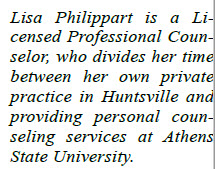Focusing
 By: Lisa Philippart
By: Lisa Philippart
In my last article, we discussed the concept of felt sense. Felt sense describes the internal bodily awareness that arises from the mind’s increased awareness. It is the combination of emotion, awareness, intuitiveness, and embodiment. Eugene Gendlin created the term when working with clients, assisting them to intuitively focus inside themselves on a very subtle and vague internal bodily awareness, or “felt sense.” This sense contained information that, if attended to, would hold the keys to the resolution of the problems the client may be experiencing. Focusing is the therapeutic process developed by Dr. Gendlin that involves holding a kind of open, non-judgmental attention to an internal knowing, which is directly experienced but is not yet in words. Focusing can be used to make clear what one feels or wants, to gather new insights regarding a particular situation, and to motivate change or healing. Focusing is a process and a learnable skill. Gendlin developed a methodology to focusing based on a six step approach.

Step one: Clearing a space. When clearing a space, take a moment to pay attention inward, in to your body to see what is there when asking the questions, “How is my life going?” and “What is the most important thing for me right now?” You learn to sense these things within the body and then let the answers come slowly. You acknowledge it and recognize the bodily feeling associated with it. For example, you may be worried about a fight you had with a friend. You can put this thing outside of yourself, like on the floor in front of you. You can find the right distance between yourself and it. You are placing the thing you want to deal with outside of yourself. Then ask again what you feel. Wait and feel. There may be more than one thing. Do this until you think/feel all of your issues are acknowledged and you have placed them at the right distance from you.

Step two: Felt sense. From what came out, select one problem to focus on. Don’t allow yourself to go inside to deal with it or fix it. The purpose is to stand back from it and considerate it from the distance you created between you and it. Now there is it the issue, and you (the “I.”) Pay attention to where you usually feel things in your body. Allow yourself to accept what you are feeling and seeing. It might not be immediately clear, but just wait and see what comes. There may be a physical sensation, like a tightness in your chest, or a queasiness in your stomach. There is no right or wrong; just allow and acknowledge whatever comes.
Step three: Handle. Now you are sensing if there is a distinct quality of this felt sense that you can describe. You are sensing into your body and letting your body talk to you. Just be with this bodily sensation and wait to see what comes. You may be able to think of a word or phrase to describe what you are feeling. Some people find it easier to reach for an image or metaphor. It might be words like “tight,” “heavy,” or “stuck,” “butterflies in my stomach,” “like water falling,” or “something surging up.” Stay with the quality of the felt sense until words fit pretty closely.

Step four: Resonating. Go back and forth between the felt sense and the word or phrase or image, and check how they resonate with one another. See if there is a bodily signal (a shift like a deep breath or a sigh). There may even be a changed sensation internally…an “aha” or “yes, that’s right.” You have to have both the felt sense and the word blending together. The key is not to force a response, but to just be with the feeling and capturing just the right words to describe it. Be accepting if there is still something unclear. Accept that too.
Step five: Asking. Now ask, “What is in this sense—the whole of it?” What makes it so tight or heavy or however you described it? What does this thing that you have identified and put outside of you seem to need from you? How does it want to be with you? Difficult questions, I know. But stay with the feeling until the right words or shift allows it to give or release.
Step six: Receiving. Finally, we receive whatever comes in a gentle way. Allow yourself to stay with it for a little while. Something else may come, but stay here and show your body empathy and gratitude for its knowledge. Once you have received what your body has shared, bring yourself back slowly. Become grounded, and then ask yourself how you are and what you learned from the experience.
For more information, go to: https://focusing.org/
By: Lisa Philippart
Licensed Professional Counselor